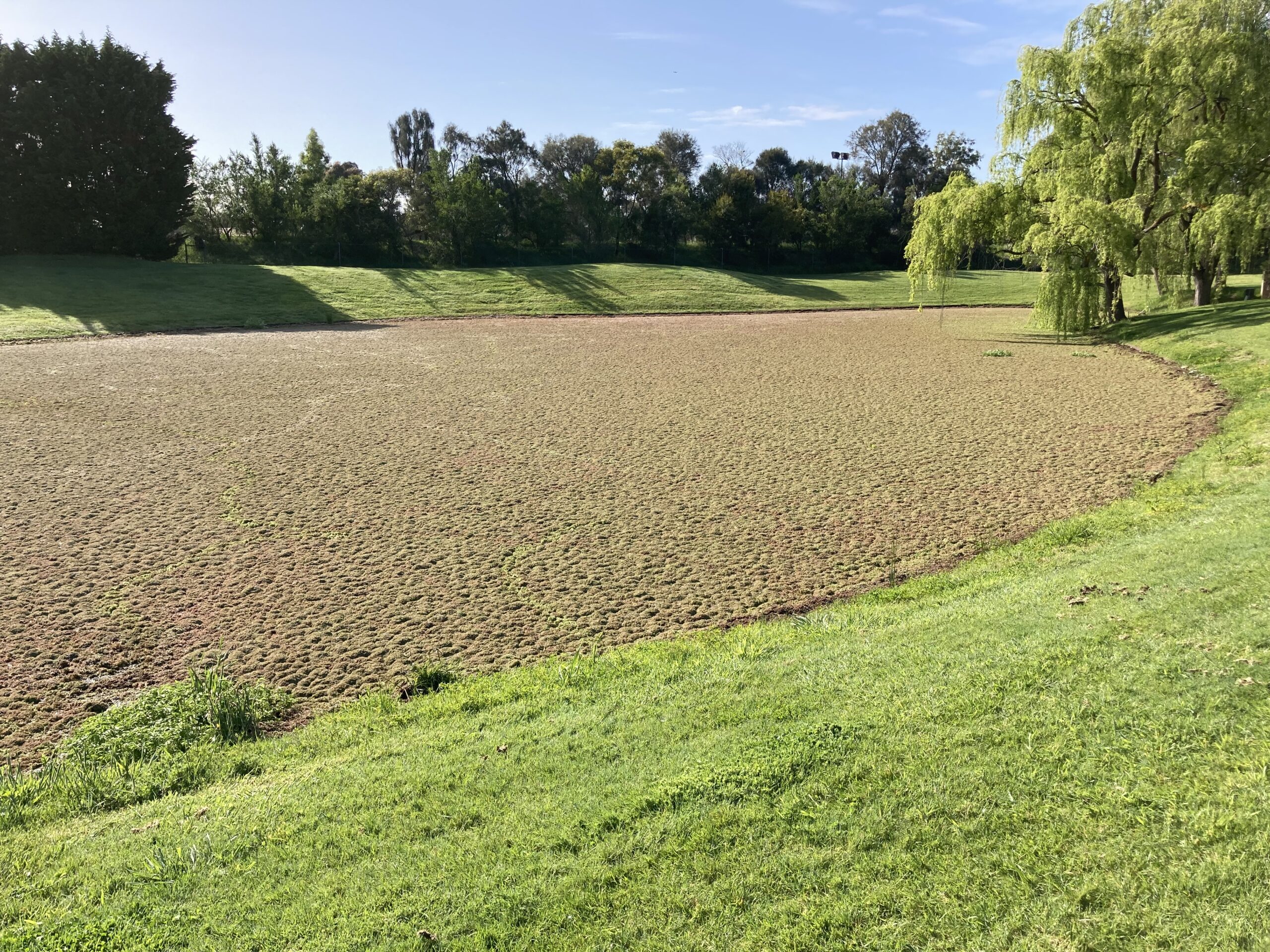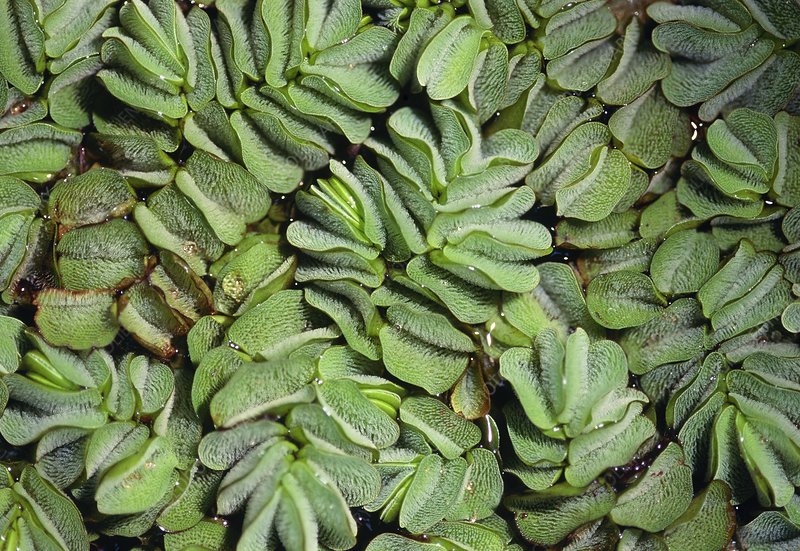
Ultimate guide to Salvinia in dams and ponds
In the sphere of freshwater ecology, salvinia, specifically Salvinia molesta, is a subject of growing concern. This free-floating aquatic fern, although not native to Australia, has established a significant presence in all mainland states, with a higher prevalence in NSW and QLD.
Despite its benign appearance, Salvinia is a remarkably invasive species. Its capacity to rapidly proliferate and form dense mats, completely covering water surfaces, is a pressing issue for freshwater ecosystems. These mats obstruct sunlight penetration, causing dire consequences for underwater biodiversity and overall ecosystem health.
This article aims to provide a comprehensive and practical overview of Salvinia, its identifying characteristics, and its impact on Australian freshwater systems, including dams. Moreover, it outlines effective management and treatment methods tailored to varying situations. The objective is to facilitate informed decision-making in dealing with this invasive species, ensuring the sustainability of our unique freshwater environments.
How to identify salvinia
Salvinia
| Scientific Name | Salvinia Molesta |
| Description | Salvinia is a free floating fern that is made up of pairs of oval, green to brown leaves connected by a horizontal stem. When infolded their appearance has been compared to the wings of a butterfly. Thin, white, whisk-shaped hairs on the upper surface of the floating leaves are a notable feature of the plant. Under the water, each plant produces other leaves that look like a small bunch of brown roots. Spore structures develop in long chains among filaments of the submerged leaves but are functionally sterile. |
| Habitat | Stationary and slow-moving water bodies, especially where nutrients are high including ornamental ponds, fish ponds, dams and irrigation dams. Mainly a weed of tropical, sub-tropical and warmer temperate regions, though it will grow in water bodies in semi-arid areas. |
| Distribution | NSW, NT, QLD, SA, VIC, WA |
| Dispersal | These plants are mainly spread by water and wind. They are spread to new areas by the disposal of garden waste as well as by animals and vehicles. |

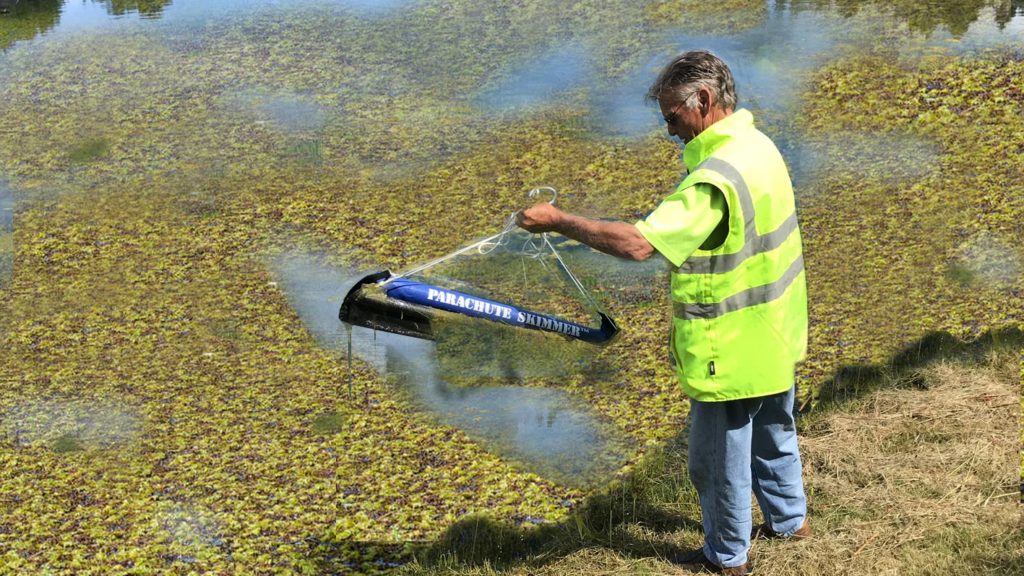
Across the Australian mainland salvinia is quite common and distributed evenly between most states like this:
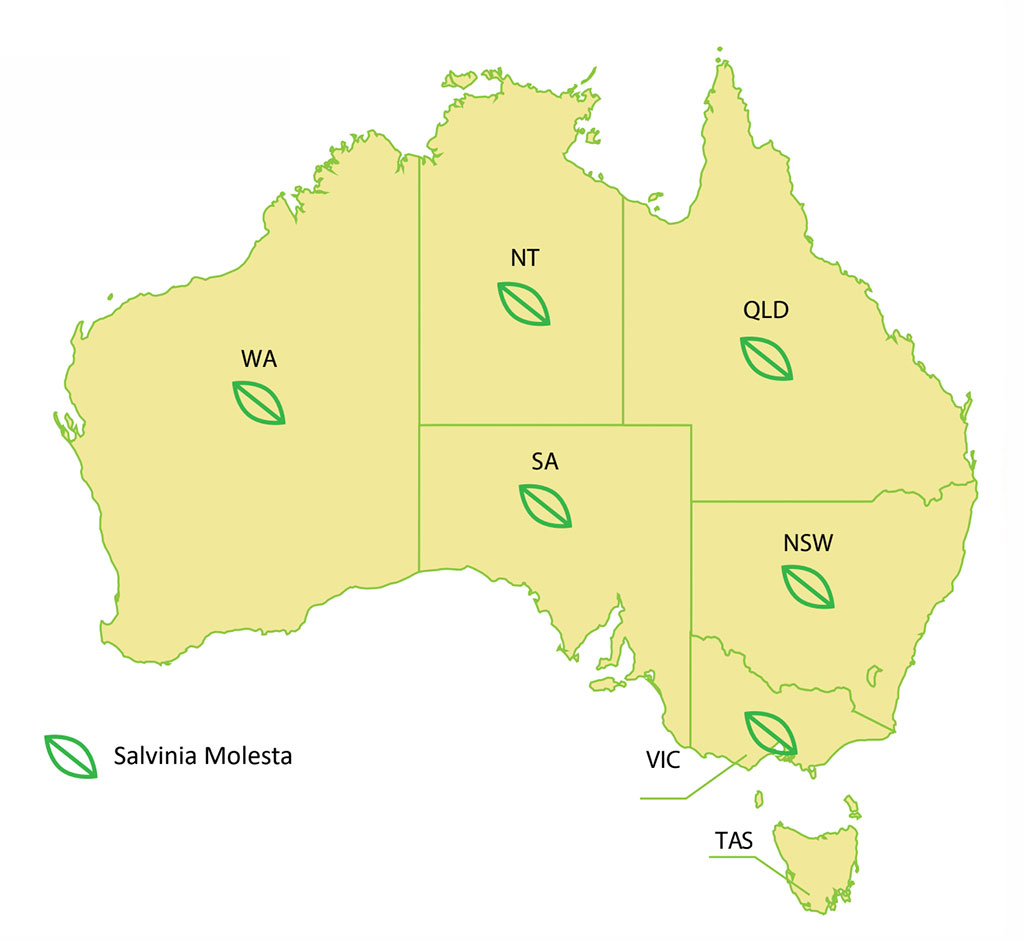
Why too much salvinia is unhealthy for your waterway
Salvinia is a free floating aquatic fern that is an introduced species in Australia. It originates from South America and prefers tropical, sub-tropical and warmer temperate regions. Salvinia is declared a noxious (harmful) weed by every state in Australia, and can be more resistant to treatment compared to other problem aquatic plants.
To add to this, the growth of salvinia can be prolific. Under optimal conditions, an infestation of the plant can double in size in less than 3 days. Salvinia’s growth depends on temperature and nutrient levels. It experiences the fastest growth in temperatures between 20 °C and 30 °C. The levels of the nutrient nitrogen in a water body determine how many buds a plant will produce.
Dense mats of salvinia can blanket the entire surface of a water body, mats as thick as 1m have been reported. This can give rise to physical and chemical changes in the water beneath which can dramatically impact the water’s quality.
The dense growths of salvinia act as a physical barrier on the water’s surface. It can interfere with light penetration into the water column. With less light, its shades out plants and reduces the ability of vegetation in the lower levels of the water body to photosynthesise. If respiration begins to overtake photosynthesis, it will lead to an increase in dissolved carbon dioxide and a reduction of the pH of the water.
The presence of salvinia also impacts gas exchange between the water and the air. The mats formed prevent oxygen diffusion into the water, thereby dramatically decreasing the level of dissolved oxygen in the water. Low levels of light and oxygen in the water impact the communities of plants and animals living in the water below, deteriorating biodiversity and habitat of the aquatic ecosystem.
The process of salvinia decomposing also reduces the amount of dissolved oxygen in the water. This creates a hostile environment that does not have enough oxygen to support most life, especially fish.
Salvinia Growth Stages
Not all treatments for salvinia are effective at any growth stage. So before taking any action to treat the salvinia it is important to fist recognise how severe the algae bloom is. Generally it will be in one of the four stages below:
Primary Growth Stage
0-30% of the water body is covered in Salvinia
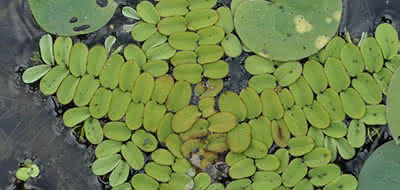
Primary growth occurs in the early stages of an infestation, when plants are not crowded. The water surface is clearly visible between plants and the plant is lying flat on the surface of the water.
Secondary Growth Stage
30-60% of the water body is covered in Salvinia

Secondary growth occurs when the water surface is barely visible but the Salvinia is still only a single layer.
Tertiary Growth Stage
60-100% of the water body is covered in Salvinia
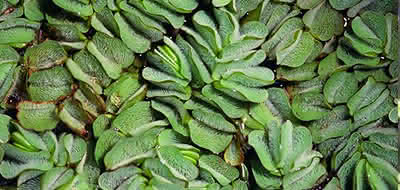
Tertiary growth occurs when the plants become crowded and mature in infestation. The water surface is no longer visible preventing light from entering the water.
Multilayered Growth Stage
100%+ of the water body is covered in Salvinia

Tertiary weed mats can become multilayered, displaying ridge-like thickenings as layers build up affecting the water beneath by eliminating submerged plants and algae, preventing photosynthesis and blocking oxygen diffusion from the air resulting in an anaerobic environment.
After establishing which stage the salvinia is currently in, use that information combined with the salvinia treatment methods below to treat your water body appropriately.
Salvinia Treatments
Just like other weeds including Duckweed, there are two main types of treatment for Salvinia available. These are:
- Aquatic herbicides (chemical & natural based)
- Physical removal (manual & machine)
Discover which treatment is appropriate for your water body based on the stage of your salvinia growth.
| Chemical Herbicide | Natural Herbicide | Manual Removal | Machine Removal | |
| Primary Growth | ✅ | ✅ | ✅ | |
| Secondary Growth | ✅ | ✅ | ✅ | ✅ |
| Tertiary Growth | ✅ | ✅ | ✅ | |
| Multilayered | ✅ | ✅ |
Aquatic Herbicides
All approved aquatic herbicides can be used on all species of Salvinia but not all aquatic herbicides
are effective against all growth stages.
The following Aquatic Herbicides are successful on primary and secondary growth stages:
- AQ200
- Calcium dodecyl benzene sulfonate
- Glyphosate
- Orange Oil (natural based)
The following Aquatic Herbicides are successful on tertiary stages of growth:
- AQ200
- Glyphosate
The following Aquatic Herbicides are successful on multilayered stages of growth:
- AQ200
Benefits of Chemical Control
Typically only one full application with follow up spot treatments is necessary and the treatment is fast, killing salvinia within 7-14 days.
Disadvantages of Chemical Control
Treated plants remaining in the water can cause deoxygenation within the system, affecting water quality. However, if left untreated water quality will continue to decline. However, if left untreated
water quality will continue to decline. Treating with aquatic herbicides may see a short term decline in water quality, however once cleared a rapid recovery takes place.
There is a possibility of spray drift onto non-target vegetation.
There is a withholding period once the herbicide has been applied meaning the water cannot be used for either irrigation or watering stock until the breakdown of the herbicide (excludes orange oil).
Physical Removal – Salvinia Skimmers
Physical removal can be a labour-intensive method, but has the advantage of being ecologically benign. Small infestations of Salvinia in accessible areas can be removed with rakes and fine-mesh nets, and used as either fodder or compost. The disadvantage of this method is that under optimal conditions, Duckweed can double its population in 2 to 10 days.
Advantages of Physical Removal
- Removes extra nutrients caused by the breakdown of Salvinia thereby reducing the likelihood of future blooms.
- A dense coverage consumes a lot of oxygen leaving little left for fish and other aquatic organisms. Avoids fish kills by ensuring adequate oxygen levels remain.
- Removes habitat for breeding mosquitoes.
Aquatic Surface Skimmers
Can be used on all species of Salvinia and primary, secondary and tertiary growth stages. This method is best used in conjunction with spray treatments or when partial removal is desired.
Physically removing Salvinia from the water’s surface will reduce the likelihood of future blooms by decreasing the amount of nutrients in your water. Nutrient-rich water lets aquatic vegetation thrive, meaning you might experience more infestations of unwanted Salvinia. Easily remove Salvinia from your water body in 4 steps:
- Toss the skimmer in the water
- Slowly pull it back in using the string attached
- Dump the Salvinia out onto the bank or into a
container for easy transport - Repeat
Tips
- Keep collected Salvinia away from water’s edge to avoid recontamination.
- Use the collected Salvinia on your garden! Salvinia is a great fertiliser.
Aquatic Harvesting
Amphibious Aquatic Harvesting machines can be used on all species of Salvinia and is better suited to larger infestations where chemical treatment is not desirable or practical.
Aquatic harvesters can remove the bulk of an infestation in accessible areas, and other control methods are then required for the remnant Salvinia left close to edges, or in shallow or inaccessible areas.
Maintaining a Healthy Water Body
Once your water body is clear of salvinia, it is time to start working towards maintaining a healthy water body. Achieving a balanced ecosystem requires ongoing attention and the implementation of the right practices. But what are the best practices and how can you ensure your pond or dam remains healthy?
We have lots of tips and guides throughout our blog, so feel free to search here and for a full step by step comprehensive guide to managing Salviniad, including detailed product quantities and recommendations please download our complete Salvinia Manual.



